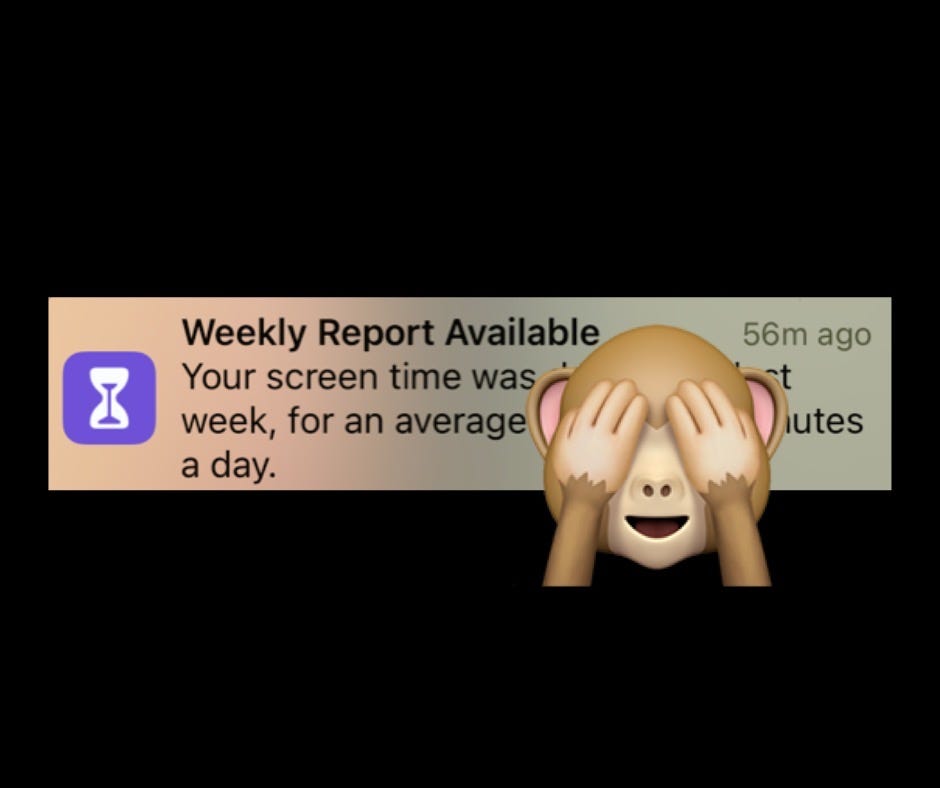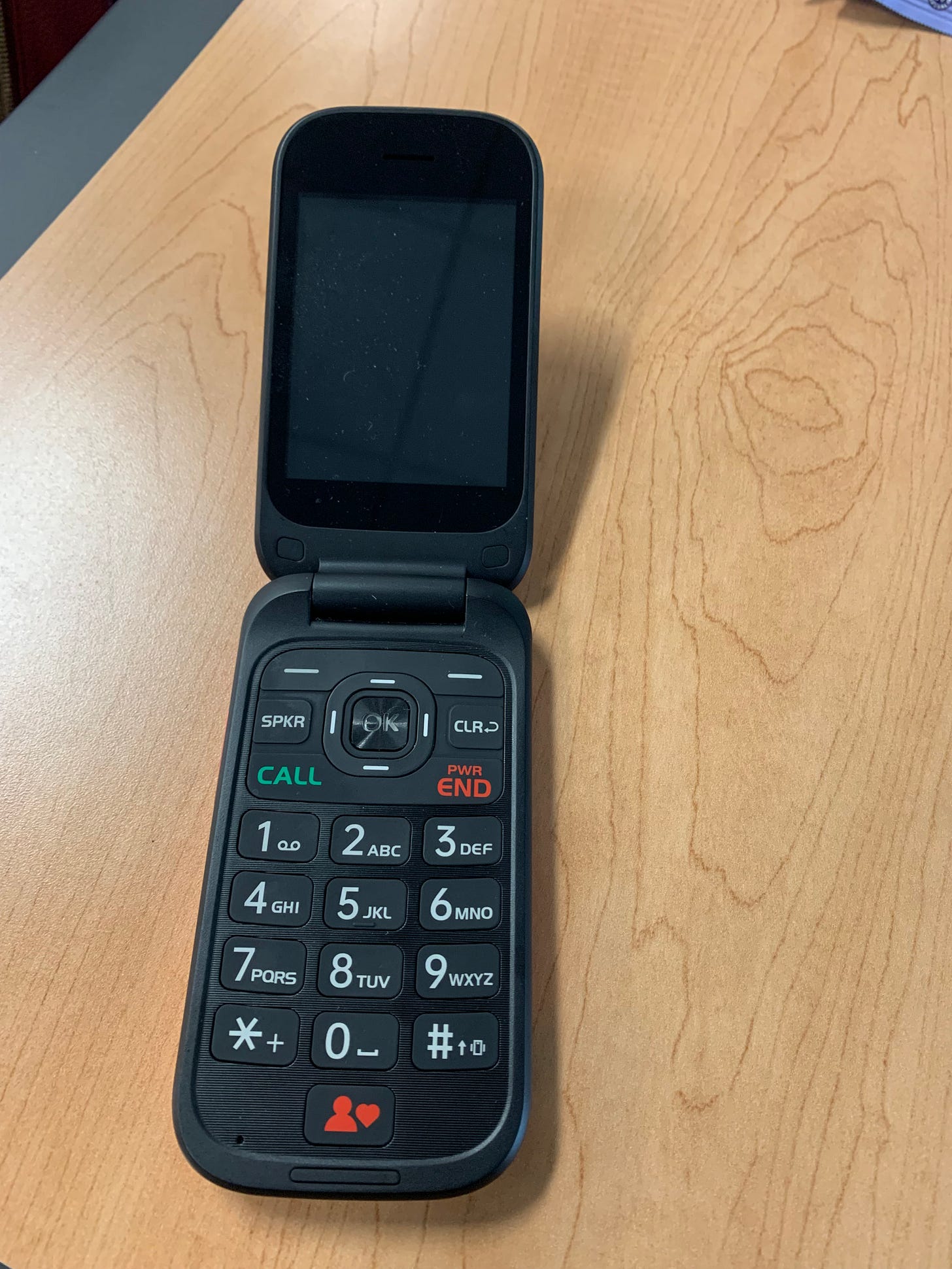Why and How I Broke Up With My Smartphone
My Smartphone Addiction
For years now, I’ve had a nagging feeling that I was addicted to my smartphone, and that the addiction was kind of ruining my life. The ever-present urge to scroll was taking me away from my children, my husband, and, perhaps most importantly, myself.
Every Sunday morning, I’d feel a mix of dread and shame when the screen time “Weekly Report Available” notification flashed across my iPhone. Rather than participating in real life, another week had gone by in which I spent a heinous amount of my time scrolling content that I barely remembered afterward. Why wasn’t I able to exercise even a modicum of self control here?
The parental guilt spiral would follow. I’d relive the multiple occasions over the past week that I’d responded with irritation to my kids when they’d tried to get my attention while I was looking at my phone. These moments happened at home, at the park, on walks around the neighborhood, at the library, on play dates, at school drop-off and pick-up, and even in the car at red lights.
I knew my phone was making me a worse parent and a worse human, and I felt pathetic that I couldn’t get a handle on this addiction. I’d then run from those feelings of guilt and shame by dissociating on my phone some more. It was a vicious cycle.
Failed Attempts to Get a Grip
I’ve tried to set limits with my phone use many times over the years, but nothing ever worked for long. “Just turn it off or leave it on the other side of the house,” Google recommends. Sounds simple enough, but what if there’s an emergency and someone needs to reach me? With a child in school, a spouse who frequently travels for work, and aging parents out of state, I didn’t feel like disconnecting from my phone was an option.
Deleting addictive apps like Facebook and Instagram didn’t work for me either. I’d just use the browser instead, and when that got too tedious, I’d re-download the app, disgusted with myself and also resigned to my disgustingness. I also tried downloading apps that blocked my access to other apps (the irony is not lost on me). Sometimes I even paid for them. This might work for a few days, but eventually I’d find a way around the block, or as soon as the block ended, I’d be binging again. I felt like I was just trying the same things over and over again expecting a different result. I was behaving insanely and I knew it and I couldn’t stop.
Lightbulb Moment #1
Then, a couple months ago, buzz began to spread about
’s new book, The Anxious Generation: How the Great Rewiring of Childhood Is Causing an Epidemic of Mental Illness. Fully aware of how unhealthy my own relationship with my phone was, Haidt’s argument about the damaging effects of these devices on the mental health of young kids felt almost like stating the obvious. And yet, 53% of American children have a smartphone by the age of 11. At five and two, my children were too young for this to be a pressing issue yet, but I knew the day was not far off. It seemed clear that prohibiting them from getting a smartphone and social media accounts until their late teens was the right choice.Of course, there was one minor problem with my plan. It doesn’t take a genius to anticipate how a broody teen or preteen would react not being allowed to own a smartphone, when she saw her own mother constantly glued to her smartphone. I knew that unless I made a real change in my own behavior, I wouldn’t have a leg to stand on with this “ban.”
Lightbulb Moment #2
A short while later, I was at a playdate at the park, when I saw a friend of mine holding a “dumbphone,” i.e., an old-school flip phone. Intrigued, I asked her about it. She told me a story I knew quite well: how she’d been hopelessly addicted to her smartphone and guilt-ridden about how it was taking her away from her children. How she’d tried to set healthy limits around her smartphone use, but it never worked, until finally she decided to take drastic action and get the dumbphone. It had been a full year since she’d ditched her smartphone, and while there’d been a few obstacles to overcome, she’d never once regretted it.
My mind was buzzing. I thought about how the crux of my issue with my smartphone was my inability to ignore it if I had it on me, and how I felt like I always had to have it on me in case a loved one needed to reach me. A dumbphone would solve that. I could keep the dumbphone on me 24/7, but thanks to its dumbness, it wouldn’t hold my attention the way the smartphone did.
I’d actually half joked to my husband in the past that I should get a flip phone, but I’d never been too serious about it because, well…what about GPS? What about being able to Google random things on the fly? What about portrait mode?
Hold up. Was I really going to let something like portrait mode stand in the way of overcoming my addiction? Surely standalone cameras are still a thing.
And GPS…had I not started driving at age 16 with nothing more than a printout from Mapquest to guide me around town? Had my brain rotted so severely since then that I couldn’t cope without GPS now at age 38? And even if irreparable brain rot had set in, couldn’t I just purchase an old school GPS machine on Amazon as a backup?
I made a mental list of all the features of my smartphone that I’d come to depend upon, and I began thinking about workarounds for each of those. It actually wasn’t too hard to do, in most cases.
Pulling the Trigger on the Dumbphone
I went home and bought a dumbphone. As I went through the process of transferring my cellular service from the smartphone to the dumbphone, I literally started sweating. Was I making a huge mistake? It almost felt like I was about to sever a limb. But what kind of limb? A limb that was rotted with gangrene and threatening to poison the rest of the body! Yes, it had to be done. Steeling myself, I clicked the final button to complete the transfer.
I’ve had this dumbphone for about a month now and, like my friend at the park, haven’t had a single moment of regret. This is not to say things are perfect and I’m completely cured. The underlying compulsion to be plugged in is still there, and my husband will be the first one to tell you that I’m spending more time on my laptop now that I’ve given up my smartphone. But the trend is in the right direction, which is something I haven’t been able to say since 2010 or so when I got my first iPhone. After all, you can’t really take your laptop to the park with your kids, the library, or even the doctor’s office. You can take a book, and in fact I’ve finished three books since I broke up with my smartphone!
Another positive development: I spoke to a dear friend on the phone for the first time in years (because texting, our usual mode of contact, is way too onerous on the dumbphone). Also, I am finally learning my way around the city I’ve lived in for almost eight years now that I’m no longer robotically following commands from Apple Maps.
Since ditching my smartphone, I feel unburdened. I also feel a little bit smarter, like my attention span is starting to recover from years of abuse. That feeling of jittery emptiness I used to get after a lengthy scrolling session is gone, replaced by a weird sensation that feels almost like calmness. And when my kids ask me to play with them, I find myself saying “sure!” a lot more often than “in a little bit.”
Ditching the smartphone is a drastic move that feels almost absurd in 2024, but for me it was necessary. Rather than continuing to beat myself up for being addicted to a device that was specifically designed to be addictive, I realized I needed to just break up with the device.
When I saw my friend with her dumbphone, it gave me the final push I needed. I thought if she could do it, so can I. And I’m here to tell you that if I could do it, so can you! (If you want to, that is.)




I commend you whole heartedly, Christina!! Your children’s childhoods are that much richer, I’m sure! Bravo!!
A nice read!For half a year I've been considering,once my smartphone dies,but the crux of what forbids me to is whatsapp.But honestly,I feel like I wouldn't mind switching to dumbphone if I have to convert to t9 texting.